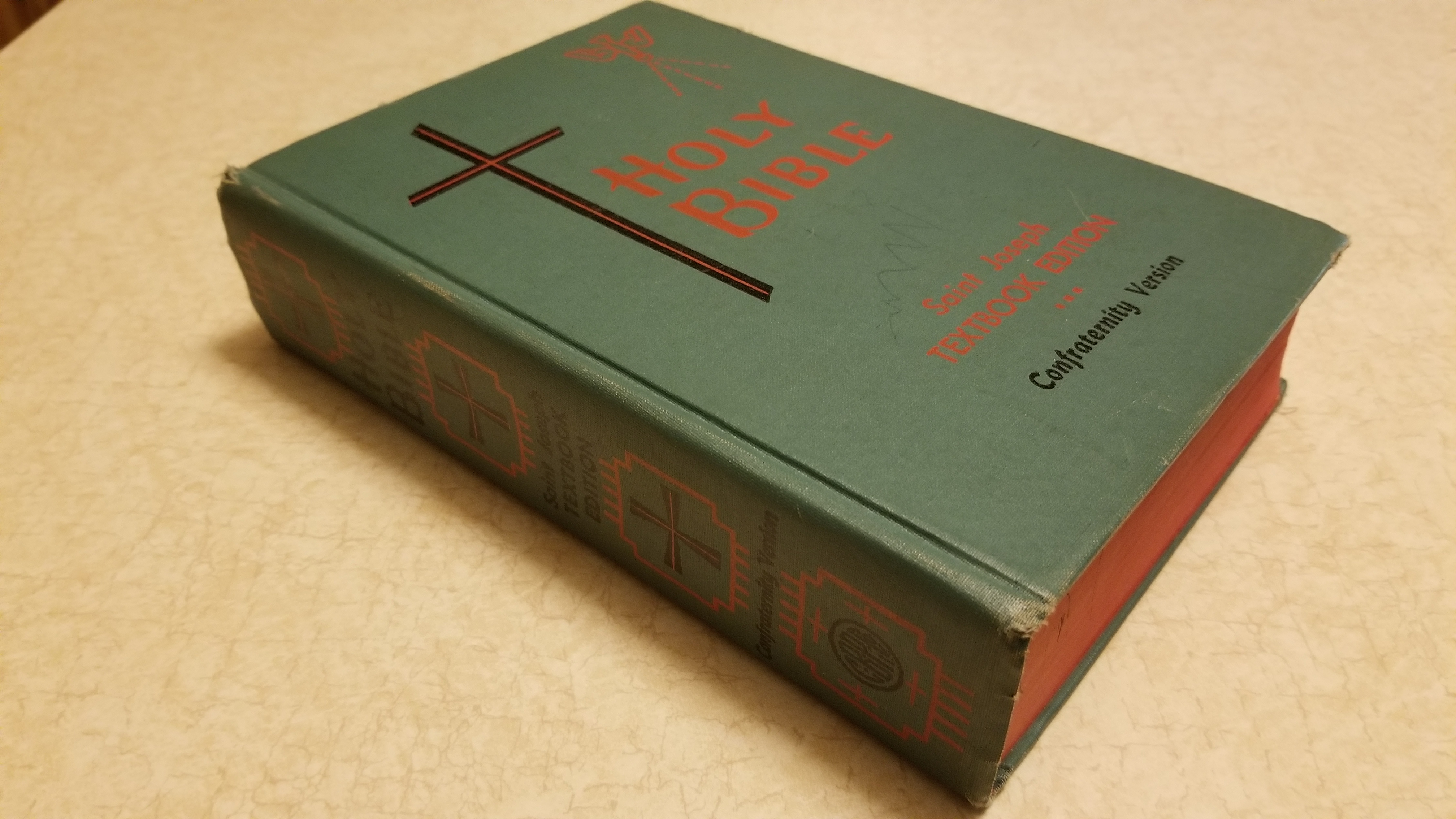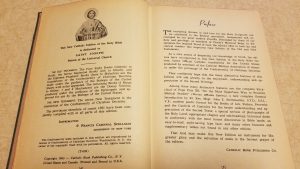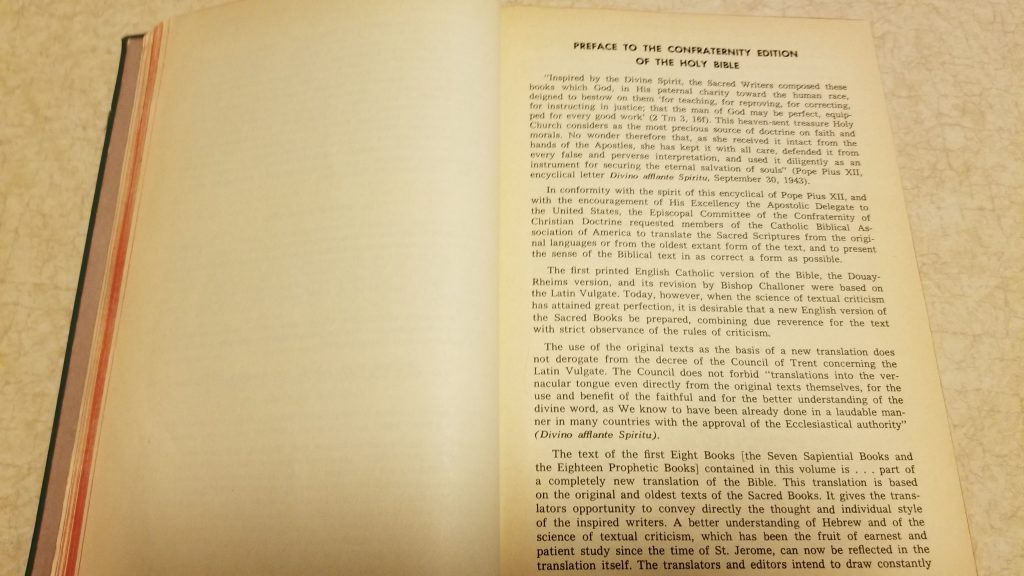
This is the first in a two-part series on the Confraternity Version — the predecessor of the New American Bible.
Several years ago, I found a used Confraternity Bible (copyrighted in 1963) in a Catholic gift shop. It caught my eye, because my home parish was using a Stations of the Cross prayer book with quotations from the Confraternity Version during Lent.  I referred to it occasionally, but it soon fell into disuse. I dug it out a few days ago and began reading the preface. I quickly realized that I had some misconceptions about the Confraternity Version.
I referred to it occasionally, but it soon fell into disuse. I dug it out a few days ago and began reading the preface. I quickly realized that I had some misconceptions about the Confraternity Version.
History
I used to think that the Confraternity Version was translated from the Latin Vulgate, and after Pope Pius XII released the encyclical Divino Afflante Spiritu, which commended translations from the original languages, the translators abandoned the project and began working on the New American Bible. The preface to the Confraternity Version clarifies that the Old Testament was translated from the original languages, however. Pope Pius XII issued Divino Afflante Spiritu in 1943, just after the Confraternity New Testament was translated from the Latin Vulgate. Thus, the Confraternity Version is an interesting mix — the New Testament was translated from the Vulgate, and the Old Testament was translated from the original Hebrew and Greek.
In addition, The Old Testament was never finished, even though the translators were working on it for roughly 20 years. The 1963 edition I have contains the Confraternity translation of the first eight books (from Genesis to Ruth), the seven books of poetry and wisdom (from Job to Sirach), and the eighteen prophetic books. The remaining historical books were reprinted from the Douay-Challoner version. As I understand it, much of the Confraternity Old Testament became the basis of the 1970 NAB Old Testament.
In the next part, I’ll discuss my impressions of the translation and notes.

I’m not sure I follow you, that that which goes under the name ‘Confraternity Bible’ is really just the 1941 Confraternity New Testament, which was not a new translation but was a modest revision of the Rheims NT of 1899 which was revised by occasionally referring to the Greek, and was designed to bring the Vulgate closer to the Greek, but it was not itself directly based on or translated from the Greek combined with the 1899 Douay OT. But as the books of the OT were being translated anew from the original languages, the books of the OT were gradually replaced with the new versions as they were produced.
So, if your edition is 1963, that means that it contains all of what would later be called the NAB OT that had been produced up to that date, with the remaining books being the 1899 Douay OT.
It is true that when Divino Afflante Spiritu was published, the OT was nearly complete, but they hadn’t been working on for 20 years, they had actually only been working on it for 4 years. The reason why they were able to produce that text so quickly is that, like the 1941 NT, it was a new translation but was merely a modest revision of the Douay Rheims.
When Divino Afflante Spiritu was published, the decision was made to abandon the project of revising the Douay Rheims and produce a new translation from the original languages.
Even though the OT is essentially the 1970 NAB OT text, there are some stylistic differences. The 1970 NAB OT used the traditional English spellings for proper names instead of the Vulgates e.g. Hosea’ instead of the Vulgate’s ‘Osee’ or ‘Jeremiah’ instead of ‘Jeremias’ etc. When first published, these books all used the Vulgate’s spelling for names.
Also, the OT books were given new names to conform with their names in Protestant Bibles, e.g. 1 and 2 Samuel and 1 and 2 Kings rather than the Vulgate’s 1,2,3,4 Kings. Also, in 1969, the book of Genesis was revised again to make its style fit the rest of the OT.
This new translation was called ‘The Confraternity Version’ until 1969 when it re-named ‘The New American Bible.’
Thank you for the additional detail, Biblical Catholic. The translation history is complicated. Are there any resources you’re aware of that explain the history in depth for readers who might be interested?
When I mentioned the roughly 20 year time frame for the Old Testament, I was referring to the period from 1943 through 1963, when the Bible I own was published. The preface to the Old Testament in my edition makes no mention of any translation efforts to revise the Douay Old Testament. It says that the revised Old Testament books were translated “from the original languages or from the oldest extant form of the text”. If Wikipedia is correct, it sounds like the new translations of the books of the Old Testament were gradually published over the course of roughly 20 years.
It stands to reason that if the translators had begun revising the Douay Old Testament, they would have stopped and changed course after Divino Afflante Spiritu. However, they make no mention of that change in their preface.
Do you know if the Psalms that appear in the 1960s Confraternity Bibles are the same as the original 1970 NAB Psalms? Or was the psalter revised prior to final publication?
” Are there any resources you’re aware of that explain the history in depth for readers who might be interested?”
The preface to the Old Testament of the NABRE gives a very detailed history of the production of the text. The truth is that the NAB has been in a state of almost of almost constant revision since 1936, more than 80 years.
Wikipedia gives a fairly good overview of the “Confraternity Bible.” In actuality, the Confraternity Bible was finished, but never published as a single, complete edition. It was published (in addition to the copy you mention, Mark) in volumes (noted from the Wikipedia page):
1941: New Testament [currently available from Scepter Publishers]
The Book of Genesis – 1948
The Book of Psalms – 1950 and 1955, reprinted 1959
Volume One: The Octateuch: Genesis to Ruth – 1952
Volume Three: The Sapiential Books (Job to Sirach) – 1955
Volume Four: The Prophetic Books (Isaias to Malachias) – 1961
Volume Two: The Historical Books – Samuel to Maccabees (1 Samuel to Esther; 1 and 2 Maccabees) – 1969
“In actuality, the Confraternity Bible was finished, but never published as a single, complete edition.”
Sure it was, it was published in a single volume in 1970 together with the New Testament under the name ‘New American Bible’ with the minor stylistic changes I mentioned in my earliest post.
There were a few more changes than stylistic. As noted below, Genesis was given an “overhaul” (my term, in no way an accurate translation nomenclature!). There is no “complete” Confraternity Edition available. There was a scuttle a year or so ago that such an edition was published in the Philippines. Yet, this was found not to be so. The only way to obtain a “complete” Confraternity edition is to search for the five individual volumes.
I noted the re-translation of Genesis in my overview that I referred to above. Did you read my overview?
There were a total of 5 major changes made in the transition from the ‘Confraternity version’ to the ‘New American Bible.’
1. Genesis was replaced with a new translation
2. The text was completely de-Latinized, replacing the Latin forms of all the names with the Hebrew forms that are commonly used in Protestant Bibles, e,.g. ‘Hosea’ instead of ‘Osee’, ‘Elijah’ instead of ‘Elias’ etc
3. The names of the OT books were changed to match the names in Protestant Bibles, e.g. ‘1,2 Samuel and 1,2 Kings’ rather than the ‘1,2,3,4 Kings’ of the Vulgate
4. The order of the books in the OT was changed from the Vulgate order to the order found in Protestant Bibles (which is why the order of the OT books in the NAB is different from the order in the RSV CE, the RSV CE retains the Vulgate ordering)
5. Explanatory notes were added in the margins
I noted all of this in my overview…what you think I left out? Note, my source for all of this is the Introduction to 2011 NABRE, so if any other change that I missed, it is one that is not officially acknowledged by the translators of the NAB.
It sounds like the primary confusion is how to classify the Old Testament translations that were released between 1943 and 1969. They were published under the name “Confraternity Version,” but many of the books were used in the NAB with only minor editing. Furthermore, they were translated from the original languages, unlike the Confraternity New Testament (which was translated from Latin). It makes good sense to consider them part of the NAB project, rather than the Confraternity Version. But since they were published under the Confraternity name, I suppose they overlap.
Well, the version of the Confraternity OT that was produced back when they only want to make a minor revision of the Douay Rheims, the project that was abandoned when they decided to produce a brand new translation from the original languages has never, to my knowledge, been printed at all.
The complete history of the NAB is as follows:
In 1936, the Catholic bishops of the United States decided to produce their own revision of the 1899 Challoner Douay Rheims, the revision was going to be based primarily on the Vulgate, but with reference to the Greek to clarify any ambiguities or textual issues. There was going to be a modest attempt to modernize the language, eliminating many (but not all) archaisms.
In 1941, the Revised New Testament was published on its own in a single volume under the name ‘Confraternity Version’, the introduction to the NT makes it clear that the text is a revision of the DR NT. This has long been out of print, and since the copyright was never renewed when it came up for renewal in 1968, it is now in the public domain and can be distributed free of charge by anyone.
Concurrently with the production of the NT, there was another team making a similar revision to the 1899 edition of the DR OT. This version was more than 80% complete when Pius XII recommending translations from the original languages instead of the Vulgate.
The bishops then held a meeting in 1944 where they debated what to do, whether to finish the revision of the DR that was then nearly complete, or to abandon the project and produce a new translation from the original languages. The vote was contentious but by a narrow margin, the decision was made to scrap the project they were working on and make a new translation. Given that they were nearly done, it seems like it might have been a good idea to just quickly finish that project and then start a new translation, but that isn’t what they decided. They also decided at the same meeting to completely eliminate all archaic language and produce a translation in modern English. This is actually the first authorized translation into modern English.
After the decrees of Vatican II which encouraged Catholics and Protestants to work together in Bible translation, after 1965, several Protestant scholars were added to the translation team.
The OT text was published in 6 volumes from 1952-1969. At this point, a few decisions were made.
First, it was decided to change the name of the translation from ‘Confraternity Version’ which everyone thought sounded more than a little strange and parochial, to the ‘New American Bible’, to emphasize the fact that it was the first authorized new translation from the original languages to be done entirely by American scholars. It was also given this name in the hopes that it might become an ecumenical Bible that might be officially adopted by some mainline Protestant churches.
Second, since the hope was that it might be an ecumenical Bible, proper names, the names of the Biblical books and the order of the books, was changed to conform to that found in modern Protestant Bibles.
Third, explanatory notes were added to the margins.
Fourth, the book of Genesis which was the oldest of the OT books and which had a different literary style from the rest of the Bible was re-translated from scratch.
Upon publication in one volume in 1970, it was decided almost immediately that the NT was really bad and would need to be completely revised. Work on this began quickly and it was published in 1986 as the ‘New American Bible Revised New Testament.’
Limited inclusive language was used in the 1986 NT, and It was then decided that the book of Psalms would be revised according to the same principles as the 1986 NT. This new psalter was published in 1991.
This version of the NAB, officially called ‘The New American Bible with Revised New Testament and Psalms’ is the version that has been in print the longest, from 1991-2011, and is the version that most Catholics are familiar with.
It was then decided that the entire OT would be revised to make it fit more with the 1986 NT. Work on this began in 1994 and the project was completed in 2001. It was at this point that the Holy See intervened and rejected the 1991 Psalms for use in the liturgy due to the use of the inclusive language.
For the next 10 years, there was intense negotiation between the Holy See and the USCCB as well turmoil within the USCCB itself, so the revised OT was not published until 2011, 10 years after it was technically ‘done’. Because the 1991 Psalms had been rejected by the Holy See, it was decided that the psalter would also be revised.
This was published in 2011 under the name ‘New American Bible Revised Edition’.
In 2014, the bishops decided to revise the NT text to make it conform with the 2011 OT. This will be published in 2025.
So, what became known as the NAB was first authorized in 1936, and has been in a state of almost constant revision ever since.
And we have the following textual history:
The book of Genesis has been translated 3 times, once in 1952, again in 1969 and again in 2011.
The rest of the OT minus the Psalms have been translated only twice, in 1970 and 2011.
The Psalms have been translated three times, once in 1970, again in 1991, and again in 2011.
The New Testament has been translated 3 times, once in 1941, again in 1970, again in 1986, and will be translated one more time to be published in 2025.
That’s the full convoluted history of the NAB.
It sounds like you are very well informed on Catholic bibles. So I am curious, what is your preferred translation? And, to be even more specific, what bible in that translation do you think is the most accurate (including notes if applicable)?
I don’t really have a favorite or preferred translation, although I will say that I tend to favor literal translations especially those in the Tyndale family, which would mean translations like the RSV, NRSV, NASB, and ESV.
And I am extremely skeptical of new translations like the ISV, ‘The Voice’, the WEB and so forth.
One translation I would advise everyone to avoid is the New English Translation (NET) as both the translation itself and the translation itself are extremely biased and flawed.
I agree with your assessment of the NET. It has too much of an evangelical bias that it doesn’t allow other interpretations.
A bit off topic but I found possibly the only NABRE that exists in a denim design cover: the one published by St. Paul Publications based in the Philippines:
https://stpauls.ph/products/bible/the-new-american-bible-saint-joseph-edition-denim-covered-personal-size/
I don’t live in the Philippines so I can’t tell you details about it. But at least I found it.
thank you for your post. is there a confraternity Bible edition that says in Matthew 16: 18 “… one, holy Catholic Church”?
No, there is not.
I know why you are asking this question, because there was a debate (Aug. 5, 2006) where a Catholic debater named Wendell Talibong used the Confraternity Version and in that Bible it was stated in Mat. 16:18 I will build my “Holy Apostolic Catholic Roman Church”. Immediately the other debater questioned this, because it so happened that he also have the same book. It turned out that he tampered the whole page of that Bible. Recently, this year 2020 he post in YouTube that he has a different EDITION, but many religious organization such as Muslim, ADD, SDA are asking him which Edition is he using, but no statement.
I have this very version of the Bible, which I bought as part of my attendance at a Catholic seminary in 1959. One thing I have wondered about are some of the other differences I didn’t see above. For example, the NAB and NABre only show 20 chapters in 1 Kings. But the Confraternity Version shown above has 31 chapters in 1 Kings. What happened to the later chapters in 1 Kings and why were they removed in the NAB?
This is the difference mentioned above “e.g. ‘1,2 Samuel and 1,2 Kings’ rather than the ‘1,2,3,4 Kings’ of the Vulgate” so 3 Kings became 1 Kings and 1 Kings became 1 Samuel.
In my humble opinion, the New Catholic Bible is without doubt the best translation. I do like to read the 1941 Confraternity New Testament, oftentimes though.